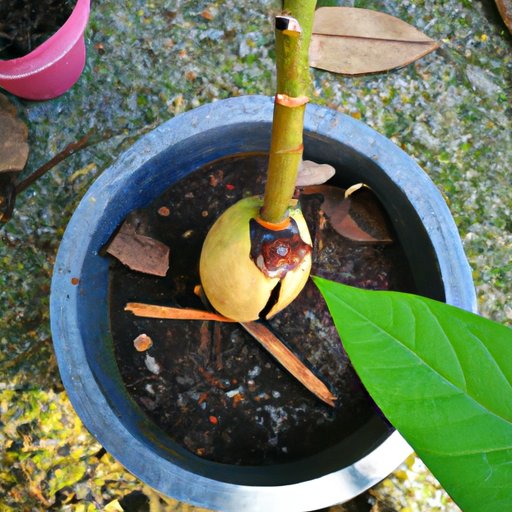
Growing Avocado: A Step-by-Step Guide to Nurturing Your Avocado Plant
Avocado is one of the healthiest and nutritious fruits, and growing your avocado tree can be a rewarding experience. The tree, however, can be challenging to grow, especially for novice gardeners, requiring the right soil, environment, and consistent maintenance. In this article, we will provide a comprehensive guide to growing an avocado tree from a seed, offering tips on soil and environment, planting techniques, propagation, maintenance, and troubleshooting common problems. With this information, you can successfully nurture your avocado plant and enjoy the delicious fruits.
Step-by-Step Guide
The first step in growing an avocado plant is to obtain a ripe avocado fruit. Next, slice open the avocado, remove the seed, and clean it. Place the seed in a jar of water, making sure that the top half is above the water level. Keep the jar in a warm, sunny location, changing the water every few days. In 2-6 weeks, the seed will start to sprout.
Once the shoot has grown to 6 inches, it is time to transplant the seedling in a pot with nutrient-rich soil. Make sure not to damage the roots during the transplanting process. Water the seedling and keep it in a warm, sunny location. Avoid overwatering, as this can lead to root rot. Allow the soil to dry out before watering again.
When the plant grows up to 12 inches, prune it to keep it at a manageable height. To prune, cut the stem back by half its size or until you reach a leaf node. Do not prune more than once a year, as this can stress the plant.
Soil and Environment
Avocado plants require well-draining soil, rich in nutrients. The soil should have a pH between 6 and 7, slightly acidic to neutral, for the best growth. You can make your soil by mixing peat moss, vermiculite, and perlite in equal amounts. Alternatively, you can purchase soil that is specifically designed for avocado plants.
Avocado plants prefer warm and humid environments, making 60-85°F ideal temperatures. They also thrive in a sunny location, but you can also place them in partial shade. The plant needs protection from cold weather and frost, which can damage the leaves and fruit.
Planting Techniques
There are different techniques of planting an avocado seed. One common technique is to plant the avocado seed directly in soil. This method involves removing the outer layer of the seed and planting it in soil with the pointed end facing upwards. Cover the seed with one inch of soil, water it, and keep it moist. The seed will start to sprout in 2-6 weeks.
Grafting is another technique used to grow avocado plants. This method involves taking a graft from a mature avocado tree and attaching it to a young plant. Grafting allows the new plant to produce fruits within its first year of growth. Transplanting avocados is also an effective method of planting avocado plants. This method involves removing an avocado seedling from its pot and transferring it into the ground, ensuring that the roots are not damaged.
Propagation
Propagation is the process of producing new avocado plants from existing ones. Avocado plants can be propagated through rooting or grafting. Rooting involves allowing the plant to produce new roots, which can then be used to grow a new plant. Grafting involves attaching a cutting from a mature avocado plant onto a new plant.
To root an avocado plant, take a cutting from the mature plant and place it in a pot with moist soil. Cover the pot with a plastic bag and keep it in a warm, sunny location. After 3-6 weeks, the plant will start to produce roots.
Maintenance Tips
Maintaining the growth of your avocado plant requires consistent pruning, fertilizing, and pest control measures. To prune an avocado plant, cut back its branches and leaves to control its height and prevent it from growing too tall. Fertilizing the plant is essential to its growth, use a balanced fertilizer that has the right amounts of nitrogen, phosphorus, and potassium. A lawn fertilizer can be used by following the application instructions provided on the label.
Avocado plants are prone to pests such as mites, mealybugs, and thrips, as well as diseases such as root rot and fungal infections. Prevent these pests and diseases by keeping the plant well-watered but not wet, and use commercial pesticides if necessary. You can also use natural predators such as insect-eating plants, or ladybugs which can be purchased at a garden center.
Troubleshooting
Common issues that arise when growing avocado plants include problems with pests, diseases, and environmental factors. Fortunately, these problems can be addressed using various techniques.
To deal with pests, use insecticides or natural predators such as ladybugs. To avoid diseases, keep the plant’s environment clean and healthy. Prevent environmental issues by ensuring the plant is planted in a nutrient-rich soil that drains well, keeping it watered but not soaking and providing enough sunlight each day.
Conclusion
Growing an avocado tree can be a challenging but rewarding experience. Although the plant requires specific soil, environment, and maintenance, following our guide will help you achieve success. By providing the right conditions, pruning, fertilizing, and preventing pests and diseases, you can enjoy a thriving avocado plant and juicy fruitsfull of flavor.




